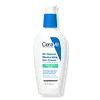What's inside
What's inside
 Key Ingredients
Key Ingredients

 Benefits
Benefits

 Concerns
Concerns

 Ingredients Side-by-side
Ingredients Side-by-side

Water
Skin ConditioningNiacinamide
SmoothingGlycerin
HumectantCetearyl Isononanoate
EmollientC14-22 Alcohols
Emulsion StabilisingIsopropyl Myristate
EmollientZea Mays Starch
AbsorbentCeramide NP
Skin ConditioningCeramide AP
Skin ConditioningCeramide EOP
Skin ConditioningCarbomer
Emulsion StabilisingCetearyl Alcohol
EmollientBehentrimonium Methosulfate
Triethyl Citrate
MaskingSilica
AbrasiveSodium Hydroxide
BufferingSodium Hyaluronate
HumectantSodium Lauroyl Lactylate
EmulsifyingCholesterol
EmollientPhenoxyethanol
PreservativeCitric Acid
BufferingCaprylyl Glycol
EmollientTrisodium Ethylenediamine Disuccinate
Xanthan Gum
EmulsifyingPhytosphingosine
Skin ConditioningPolyacrylate Crosspolymer-6
Emulsion StabilisingBenzoic Acid
MaskingC12-20 Alkyl Glucoside
EmulsifyingWater, Niacinamide, Glycerin, Cetearyl Isononanoate, C14-22 Alcohols, Isopropyl Myristate, Zea Mays Starch, Ceramide NP, Ceramide AP, Ceramide EOP, Carbomer, Cetearyl Alcohol, Behentrimonium Methosulfate, Triethyl Citrate, Silica, Sodium Hydroxide, Sodium Hyaluronate, Sodium Lauroyl Lactylate, Cholesterol, Phenoxyethanol, Citric Acid, Caprylyl Glycol, Trisodium Ethylenediamine Disuccinate, Xanthan Gum, Phytosphingosine, Polyacrylate Crosspolymer-6, Benzoic Acid, C12-20 Alkyl Glucoside
Water
Skin ConditioningGlycerin
HumectantIsopropyl Myristate
EmollientPropylene Glycol Dicaprylate/Dicaprate
EmollientPolymethyl Methacrylate
C14-22 Alcohols
Emulsion StabilisingIsopropyl Alcohol
SolventPEG-6
HumectantPotassium Cetyl Phosphate
EmulsifyingAcrylates/C10-30 Alkyl Acrylate Crosspolymer
Emulsion StabilisingC12-20 Alkyl Glucoside
EmulsifyingCaprylyl Glycol
EmollientCaprylyl Glycol Linseedate
AntimicrobialParfum
MaskingGlyceryl Behenate
EmollientGlyceryl Dibehenate
EmollientHelianthus Annuus Seed Oil
EmollientPotassium Sorbate
PreservativeSilybum Marianum Fruit Extract
Skin ConditioningSodium Hydroxide
BufferingSodium Polyacrylate
AbsorbentTocopherol
AntioxidantTribehenin
EmollientXanthan Gum
EmulsifyingZinc Salicylate
AntimicrobialWater, Glycerin, Isopropyl Myristate, Propylene Glycol Dicaprylate/Dicaprate, Polymethyl Methacrylate, C14-22 Alcohols, Isopropyl Alcohol, PEG-6, Potassium Cetyl Phosphate, Acrylates/C10-30 Alkyl Acrylate Crosspolymer, C12-20 Alkyl Glucoside, Caprylyl Glycol, Caprylyl Glycol Linseedate, Parfum, Glyceryl Behenate, Glyceryl Dibehenate, Helianthus Annuus Seed Oil, Potassium Sorbate, Silybum Marianum Fruit Extract, Sodium Hydroxide, Sodium Polyacrylate, Tocopherol, Tribehenin, Xanthan Gum, Zinc Salicylate
 Reviews
Reviews

Alternatives
Ingredients Explained
These ingredients are found in both products.
Ingredients higher up in an ingredient list are typically present in a larger amount.
We don't have a description for C12-20 Alkyl Glucoside yet.
C14-22 Alcohols is made up of synthetic fatty alcohols. More specifically, these fatty alcohols contain 14 to 22 carbons in the alkyl chain.
Its main purpose is to stabilize products. As an emulsifier, it helps prevent waters and oils from separating.
Caprylyl Glycol is a humectant and emollient, meaning it attracts and preserves moisture.
It is a common ingredient in many products, especially those designed to hydrate skin. The primary benefits are retaining moisture, skin softening, and promoting a healthy skin barrier.
Though Caprylyl Glycol is an alcohol derived from fatty acids, it is not the kind that can dry out skin.
This ingredient is also used as a preservative to extend the life of products. It has slight antimicrobial properties.
Learn more about Caprylyl GlycolGlycerin is already naturally found in your skin. It helps moisturize and protect your skin.
A study from 2016 found glycerin to be more effective as a humectant than AHAs and hyaluronic acid.
As a humectant, it helps the skin stay hydrated by pulling moisture to your skin. The low molecular weight of glycerin allows it to pull moisture into the deeper layers of your skin.
Hydrated skin improves your skin barrier; Your skin barrier helps protect against irritants and bacteria.
Glycerin has also been found to have antimicrobial and antiviral properties. Due to these properties, glycerin is often used in wound and burn treatments.
In cosmetics, glycerin is usually derived from plants such as soybean or palm. However, it can also be sourced from animals, such as tallow or animal fat.
This ingredient is organic, colorless, odorless, and non-toxic.
Glycerin is the name for this ingredient in American English. British English uses Glycerol/Glycerine.
Learn more about GlycerinIsopropyl Myristate is an emollient, thickening agent, and texture enhancer. It is created from isopropyl alcohol and myristic acid.
It is used to help other ingredients be better absorbed. It is also an emollient and may help soften and hydrate the skin.
The comedogenic rating of this ingredient depends on the concentration. Lower amounts results in a lower rating.
Isopropyl Myristate may not be fungal acne safe. It can potentially worsen acne prone skin.
Learn more about Isopropyl MyristateSodium Hydroxide is also known as lye or caustic soda. It is used to adjust the pH of products; many ingredients require a specific pH to be effective.
In small amounts, sodium hydroxide is considered safe to use. However, large amounts may cause chemical burns due to its high alkaline.
Your skin has a natural pH and acid mantle. This acid mantle helps prevent harmful bacteria from breaking through. The acid mantle also helps keep your skin hydrated.
"Alkaline" refers to a high pH level. A low pH level would be considered acidic.
Learn more about Sodium HydroxideWater. It's the most common cosmetic ingredient of all. You'll usually see it at the top of ingredient lists, meaning that it makes up the largest part of the product.
So why is it so popular? Water most often acts as a solvent - this means that it helps dissolve other ingredients into the formulation.
You'll also recognize water as that liquid we all need to stay alive. If you see this, drink a glass of water. Stay hydrated!
Learn more about WaterXanthan gum is used as a stabilizer and thickener within cosmetic products. It helps give products a sticky, thick feeling - preventing them from being too runny.
On the technical side of things, xanthan gum is a polysaccharide - a combination consisting of multiple sugar molecules bonded together.
Xanthan gum is a pretty common and great ingredient. It is a natural, non-toxic, non-irritating ingredient that is also commonly used in food products.
Learn more about Xanthan Gum